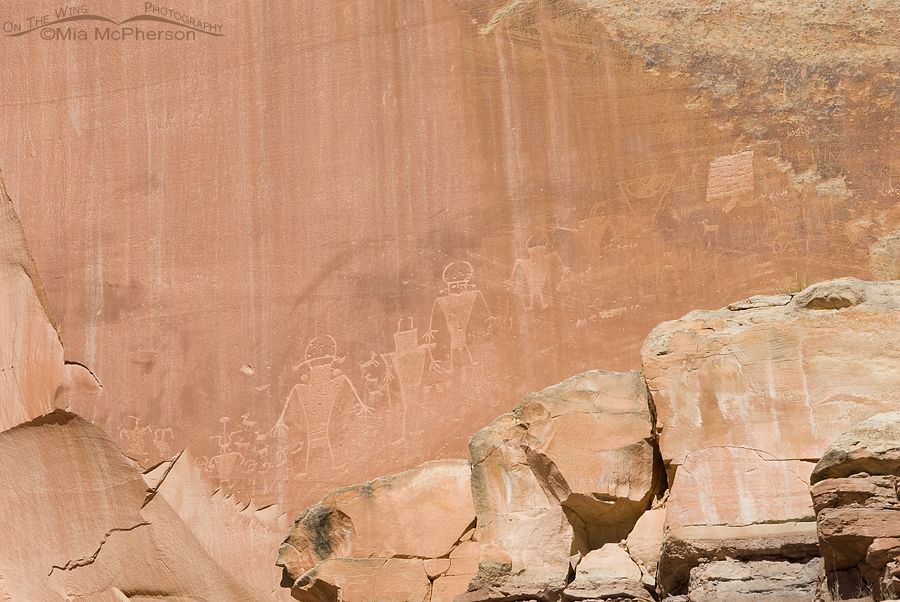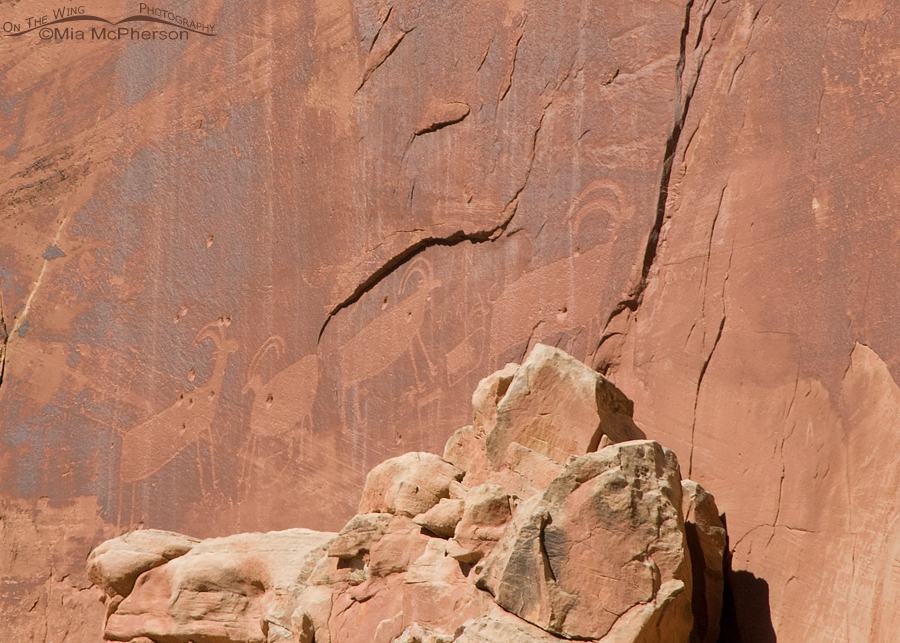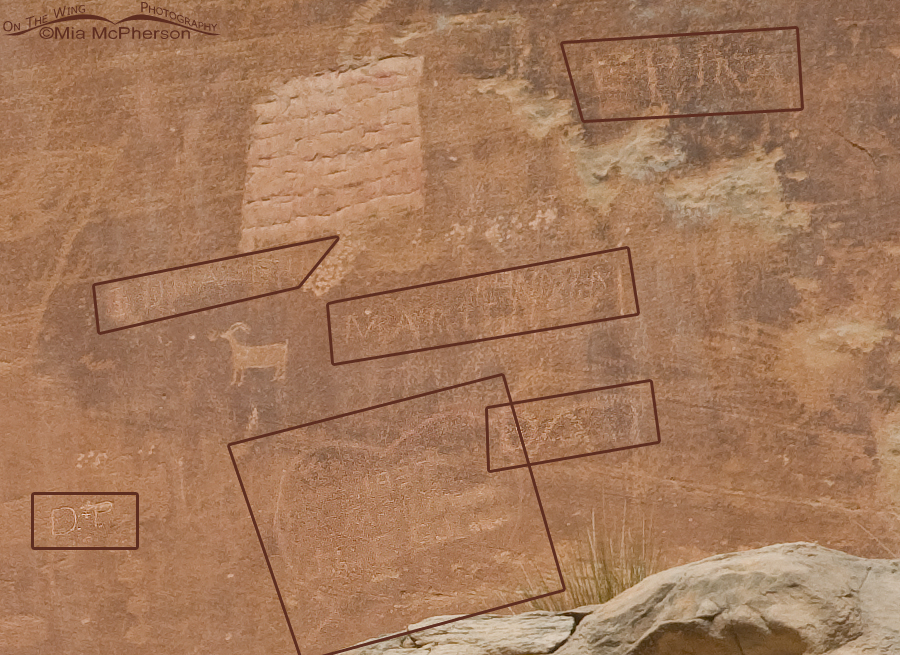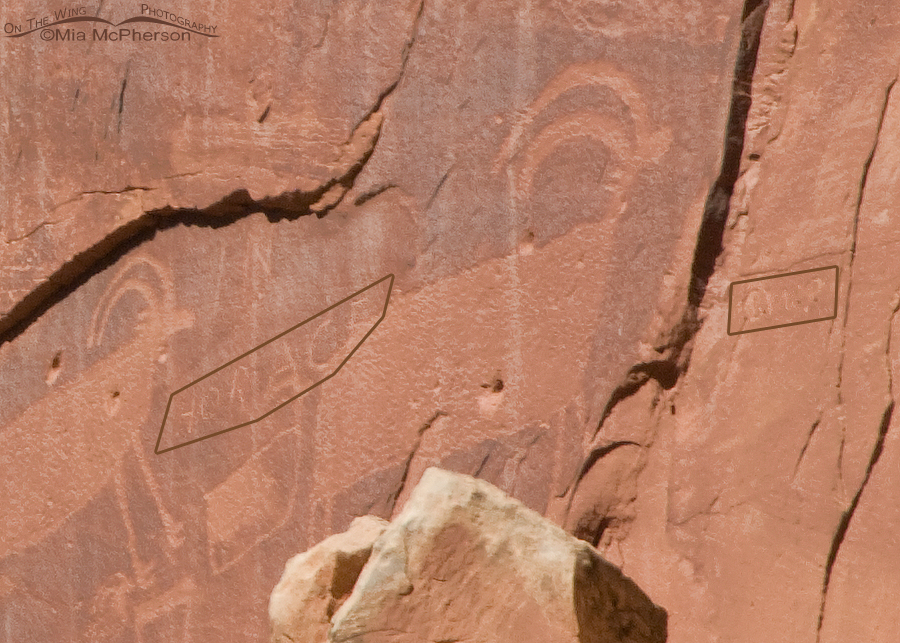 Capitol Reef Anthropomorphs Petroglyphs
Capitol Reef Anthropomorphs Petroglyphs
These Petroglyphs are attributed to the Fremont Indians who lived in this area between AD 700 and AD 1300. In this panel there are anthropomorphs with trapezoidal bodies, ear bobs, and headdresses of various sizes and the panel also includes sheep, kokopeli, and other symbols.
Petroglyphs are pecked into the rock and are most often found where Desert Varnish is found, this panel is pecked into the lower part of Wingate Sandstone. Desert Varnish consists primarily of clay minerals including manganese dioxide and iron and are cemented to the surface.
 Capitol Reef Sheep Petroglyph
Capitol Reef Sheep Petroglyph
Higher and slightly further west of the panel above another panel containing sheep is visible. I didn’t notice the sheep at first but a young woman got excited and said “Look at the sheep!”. Honestly I was looking for real sheep when she said that and I just couldn’t see them. Then the young woman pointed out the sheep petroglyphs to her male companion and me and I am glad she did. Sheep are commonly seen in Fremont Rock Art.
 Defaced Capitol Reef Anthropomorphs Petroglyphs
Defaced Capitol Reef Anthropomorphs Petroglyphs
One thing I have noticed in the petroglyphs and pictographs I have seen in Rock Art throughout the western United States is the defacement of the panels. I have outlined some of the defacement found in the Anthropomorphs Petroglyph at Capitol Reef in the image above. A heart with some writing in it that appears to be dated some time in 1930, the initials D + P and others I can’t quite make out. Today penalties for defacing Rock Art can include a year in jail and fines up to $100,000. Petroglyphs and Pictographs are ancient national treasures and should be treated as such.
 Defacement of the Capitol Reef Sheep Petroglyph
Defacement of the Capitol Reef Sheep Petroglyph
The Sheep panel also contains some defacement.
For the preservation of Pictographs and Petroglyphs it is important not to touch them because touching can loosen the stone materials and our hands could leave behind oils that damage them. Carving anything into the rock art, painting it with graffiti or other means of defacement is punishable by law. I won’t write exactly what I think of people who deface rock art because it isn’t suitable for mixed company much like my feelings regarding the recent lack of stern punishment for the “Goblin Topplers“. Destroying these national treasures robs us all.
I get so excited when I see and photograph the Rock Art of Utah and I always wonder about the artists and ancient people who created them. It must have been a hard life for those ancient civilizations yet they still had time to create art. Perhaps someday we will understand the meaning of Petroglyphs and Pictographs. Me, I just treasure each of them.
Hopefully one day I will see more Capitol Reef National Park Petroglyphs.
Life is good.
Mia
Click here to see more of my Capitol Reef National Park photos.
PS: at the very least I would have expected that the punishment for the Goblin Topplers should have included many hours of community service. But they were white, Mormon and male. In Utah justice isn’t blind.





Agree, I enjoy the Petroglyph photos but not the vandalism.Thanks for posting these, have not seen them in a long time.
I love everything about Capital Reef!. It is probably my favorite Utah NP. I was tickled to see you’re also a fan of the San Rafael Swell. Some fantastic rock art there. The Barrier canyon section of Canyonlands in the San Rafael desert isn’t far from there either. There’s some excellent rock art sites closer to SLC in NE Utah that I’m assuming you’re familiar with, it though they’re somewhat off the tourist radar. If you don’t know which ones I’m referring to, drop a line.
Defacement of these sites is a crime but when it’s done with the approval of the State Of Utah and BLM it’s worse. The damage in the Nine mile canyon area in the name of energy development on the Tavaputs plateau is a travesty. One of the longest, densest, most beautiful rock art galleries in the world has been ruined, obscured and obliterated by dust, chemicals and vibration from massive amounts of heavy truck traffic via the huge roads punched into this once pristine area. I wish I’d have taken photos of the mess the last time I was there, but I was too stunned and sickened to document the destruction.
Sometimes I feel as if I’m just another, insignificant passenger on a destruction-bound ship of fools….
It looks like a recording to prove martains landed on earth in the 1st photo.
Really what a wonderful recording of history. It is a real shame about the defacing. I am glad they now have such high penalties.
Wholehearted agreement. On all counts.
And, sadly, we have some similar oxygen thieves who deface and destroy rock painting created by our indigenous population. A pox on them all.
Petroglyphs are truly fascinating. That anyone would e studied enough to deface them is mind boggling. I’ve felt a tremendous energy coming rom them any time I’ve been lucky enough to see them…can’tbexplain it, but it was intense.
Rock art is fascinating to me and I appreciate this post very much. Check out a rare very long-necked big horn sheep found in Nine Mile Canyon:
http://www.petroglyphs.us/photographs_rock_art_nine_mile_canyon_utah_NM.htm
Just wonderful, thanks!
outstanding!!!!!!!
Interesting. Too bad about the defacement.
What shutter speed was necessary to freeze the sheep like that? -:)
For sure they are national treasures – thank you for this look at them!